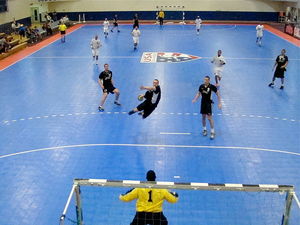If your child has discovered hockey for the first time you are probably sifting through mountains of expensive equipment and wondering which is best. Companies like Easton, Bauer, Reebok, and Mission all make great sticks, but which one is right for you child? Hockey sticks have become so advanced, a short tutorial about the characteristics of modern sticks is necessary for new hockey parents.
Material
Modern hockey sticks are usually made of composite material or wood. For a beginning player a wood stick will work just fine. Composite sticks are slightly stronger and lighter but those factors don’t make a difference unless your child is playing at an advanced level. Composite sticks are also much more expensive and as every hockey parent knows, players like to carry two sticks to the rink.
Height
The height is the most crucial element of your child’s stick. If you buy stick that is too long or too short it could cause your child to develop fundamentally bad skating posture.
Be sure to take you child’s skates and skate socks to the sporting goods store. While wearing the skates hold the stick straight up in line with the child’s body. With the blade of the stick touching the ground the top of the handle should be between your child’s chin and nose. For decades parents have been in the habit of buying improper sticks and then cutting them at home with a saw to fit the child. It is important to note that while this will fix the height of the stick, it will also affect the flex of the stick and the way the blade lies on the ice. If you don’t have to cut a stick, just don’t.
Lie
The lie of the hockey stick refers to the angle of the blade to the shaft. Hockey stick lies are typically between 4 (137 degrees) and 7 (131 degrees).
In order to determine the appropriate lie it is important that you have your child test the stick while wearing stakes. Have the child bend their knees and get into a good crouching hockey stance. While in this stance, the blade of the stick should lie flush with the ground. If you notice the majority of the blade not touching the ground a different lie may be appropriate.
Curve
Curve refers to the bevel of the stick blade. Most stick blades are not completely straight. A slight curve on the blade of the hockey stick can be used by experienced players to better control the puck.
Curved sticks may be good for the pros but they are not always appropriate for beginning players. A big curve on the blade of the stick may benefit your child if they are handling the puck with their forehand but it will severely hinder they backhand ability. A good rule of thumb for beginner players is to have little to no curve on the stick blade. Once they learn the fundamentals of stick handling they will be able to increase the curve of their blade.
Flex
Most hockey sticks have a flex value that allows the stick to recoil like a spring when the blade makes contact with the ice. As the player follows through on the shot the spring is unloaded and provides extra power on the shot.
The appropriate flex depends on the age and size of the child. A good way to test flex in the store is have your child hold the stick like they would in the game. While pushing down and forward with their bottom hand the stick should slightly flex without the child exerting too much effort.
Fortunately this is not something you have to think about too much with a beginning player. Most youth sticks have standard flex values. Youth sticks are generally more flexible than adult sticks because young players don’t shoot quite as hard as adults.
By following these guidelines you can ensure that your little Gretzky develops the proper fundamental hockey skills that they will be able to carry on with them to the next level. By the time you need a new stick your child will be able to tailor their choice to their style of play.


